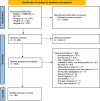Experimental designs used for optimising the effects of health interventions and implementation strategies: a scoping review
- PMID: 40855437
- PMCID: PMC12379312
- DOI: 10.1186/s12913-025-13184-9
Experimental designs used for optimising the effects of health interventions and implementation strategies: a scoping review
Abstract
Background: Optimisation is the iterative process to improve a health intervention or implementation strategy within resource constraints. This review aimed to identify which study designs are being used to evaluate the optimisation of health interventions and implementation strategies, and whether they differ by optimisation target. This review identifies possible strategies to improve future optimisation trials.
Methods: A scoping review of the Medline, EMBASE, CINAHL, and ProQuest Nursing and Allied Health Source databases was undertaken. The International Clinical Trials Registry Platform and the Australian New Zealand Clinical Trials Registry were also searched for relevant trials. Data were extracted by one reviewer for 64% of studies, and by two reviewers for 36% of studies. Data extracted included research designs, optimisation target and constraints, and whether an optimisation framework and criteria for optimisation success was used. The frequency of optimisation constraints was tabulated by experimental design and optimisation target.
Results: 183 studies aimed to optimise an intervention (n = 142) or implementation strategy (n = 39) or both (n = 2). Factorial designs were the most common design used to evaluate optimisation of an intervention (41%), whereas pre-post designs were the most common for implementation strategies (46%). Optimisation success was defined in 11% of trials and 24% of trials used a framework for optimisation.
Conclusions: This review characterises the design features of trials aiming to optimise health interventions or implementation strategies. There is a need for the use of frameworks to guide trial design and for a clear definition of optimisation success. It is recommended to consider using alternate methods that may overcome common impediments and align better with optimisation, such as adaptive designs and Bayesian statistics.
Keywords: Implementation; Optimisation; Study design; Trial design.
© 2025. The Author(s).
Conflict of interest statement
Declarations. Ethics approval and consent to participate: Not applicable. Consent for publication: Not applicable. Competing interests: The authors declare no competing interests.
Figures
References
-
- McCrabb S, et al. Scaling-up evidence-based obesity interventions: A systematic review assessing intervention adaptations and effectiveness and quantifying the scale-up penalty. Obes Rev. 2019;20(7):964–82. - PubMed
-
- Wolfenden L, et al. A call to action: more collaborative implementation research is needed to prevent chronic disease. Aust N Z J Public Health. 2022;46(5):549–53. - PubMed
Publication types
MeSH terms
Grants and funding
LinkOut - more resources
Full Text Sources


